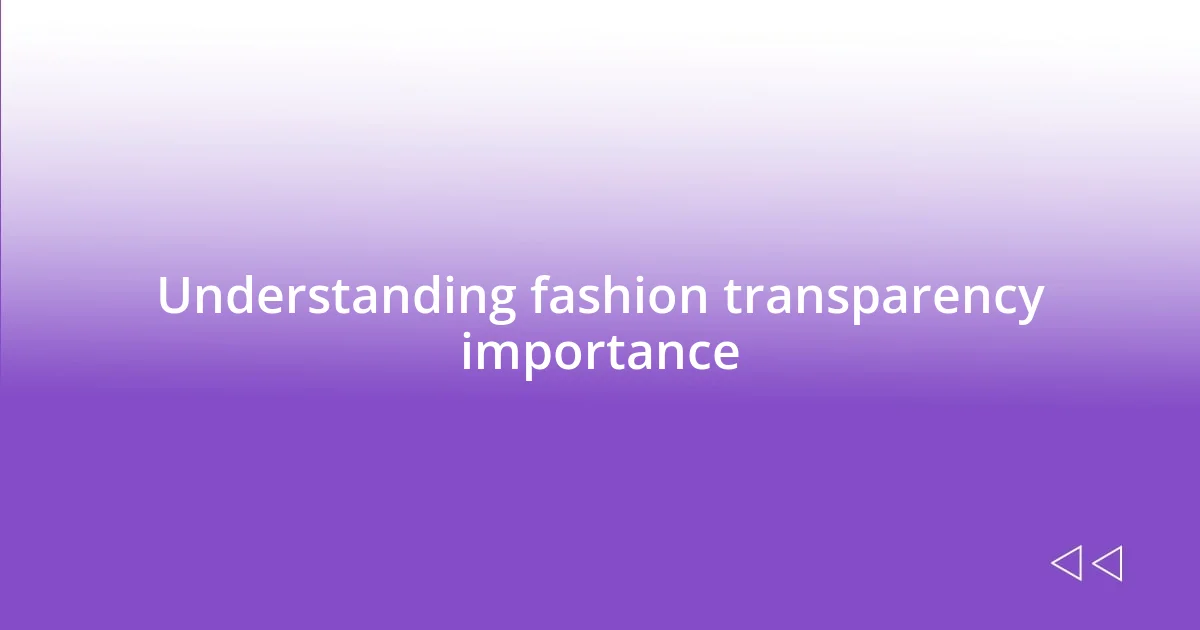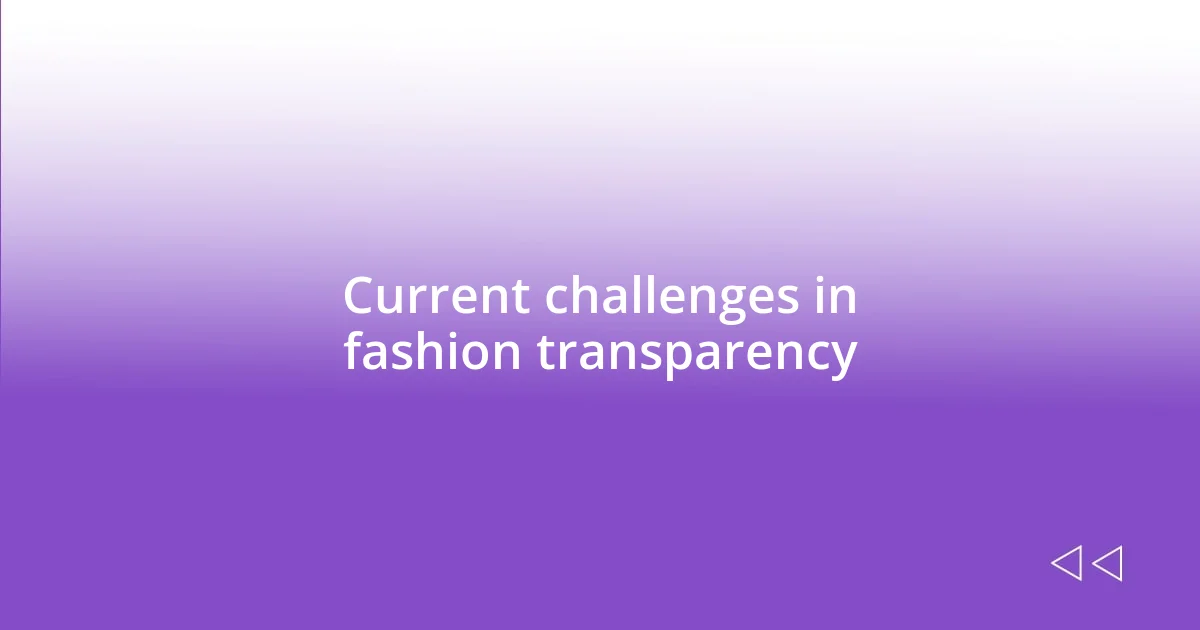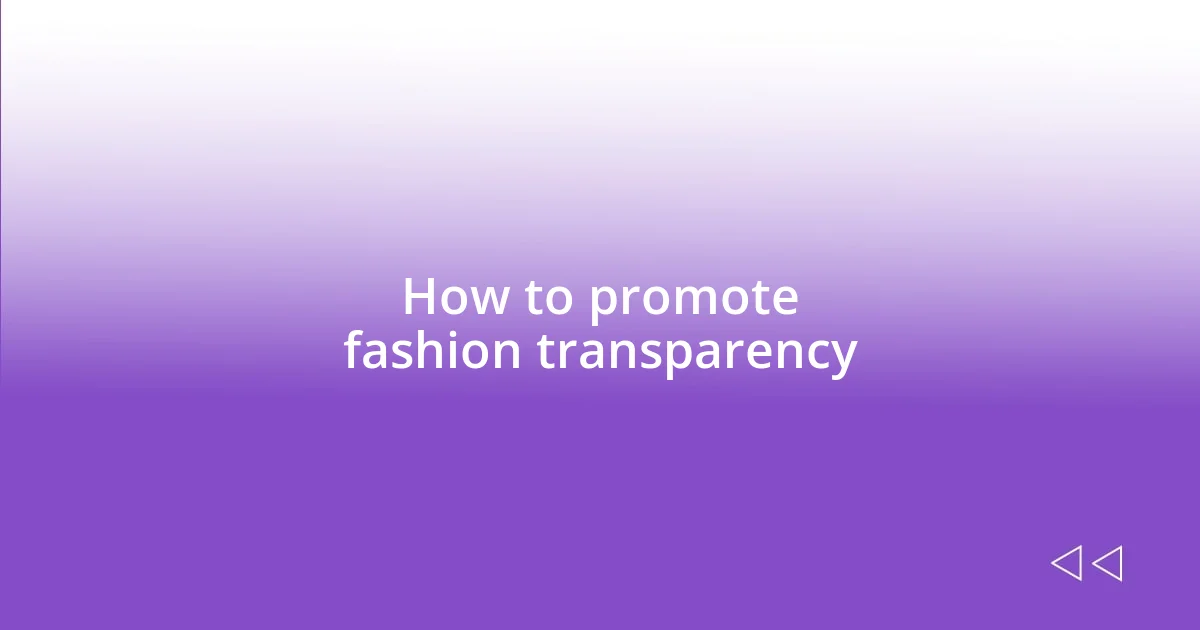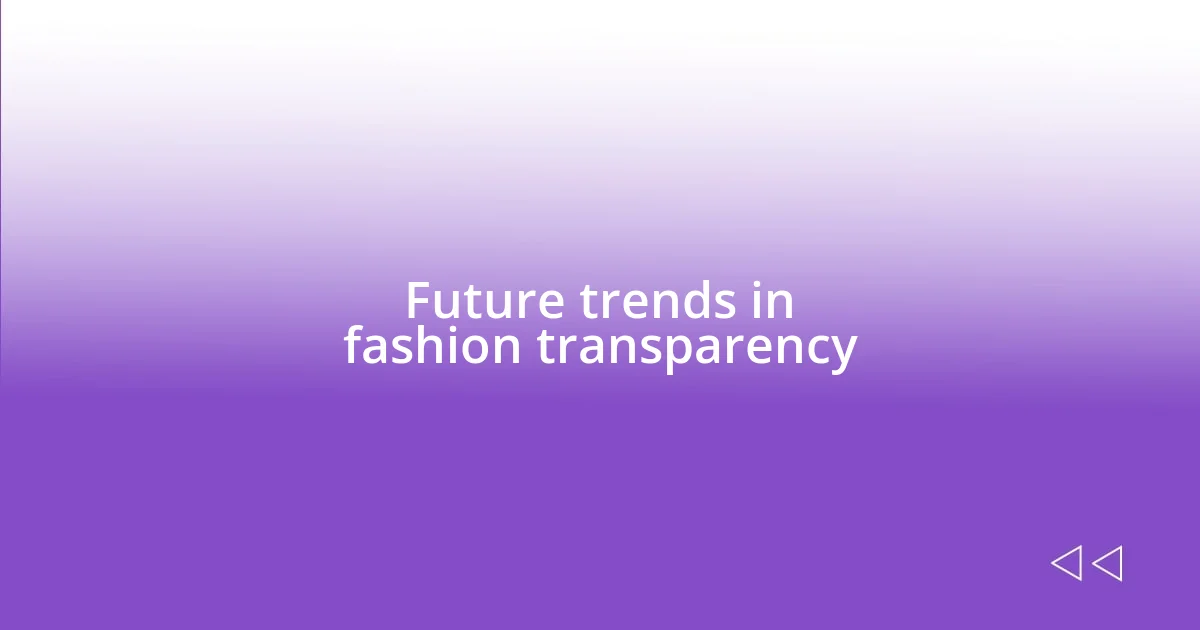Key takeaways:
- Fashion transparency builds consumer trust and loyalty, as shoppers increasingly prioritize ethical practices and sustainable sourcing in their purchasing decisions.
- Challenges include brand resistance to sharing supply chain information, lack of standardization for transparency claims, and the fast-paced nature of fashion, which often sidelines transparency efforts.
- Emerging technologies like blockchain and inclusive storytelling from workers are set to enhance transparency, allowing consumers to feel empowered and connected to their fashion choices.

Understanding fashion transparency importance
Fashion transparency is essential because it builds trust between brands and consumers. When I browse my favorite online stores, I often wonder about the journey of each garment. How was it made? Who made it? These questions linger because I want to feel a connection to what I’m purchasing, not just in terms of aesthetics but also ethics.
There’s a growing awareness about the environmental and social impact of our fashion choices, which makes transparency even more vital. I remember a time when I purchased a beautiful dress, only to later discover that the brand exploited workers in developing countries. That realization left me feeling betrayed. Wouldn’t you want to know that your choices support fair labor practices and sustainability?
In my experience, brands that showcase their production processes and labor practices not only stand out in a crowded market but also cultivate a loyal customer base. Consumers are more likely to support those who are open about where and how their clothes are made. It’s a win-win situation; we get to express our values through our purchases while brands gain respect and trust.

Current challenges in fashion transparency
Fashion transparency is riddled with challenges that hinder meaningful progress. For one, many brands are resistant to sharing details about their supply chains. When I think about this, I recall my attempts to get information from a popular brand regarding their sourcing practices. The lack of clarity made me feel as if they were hiding something. This secrecy not only breeds distrust but also prevents consumers from making informed decisions.
Additionally, there’s a significant gap in standardization across the industry. Some brands might boast about their transparency efforts, but what does that even mean? I once encountered a brand claiming to be “ethical” without any clear explanation of their certification process. The specifics mattered to me; without a common framework for what constitutes transparency, it becomes challenging for consumers to differentiate between genuine efforts and mere marketing tactics.
Moreover, the fast-paced nature of fashion complicates the pursuit of transparency. Trends emerge and fade quickly, leaving many brands scrambling to keep up while still maintaining transparent practices. I remember feeling overwhelmed last season when I saw countless new collections drop weekly; it made me question how much thought went into each piece. If brands are rushing to produce, it raises the question: can they truly provide the transparency we seek while keeping pace with consumer demands?
| Challenges | Description |
|---|---|
| Resistance to Sharing | Brands often hesitate to disclose supply chain details, creating a barrier to trust. |
| Lack of Standardization | Absence of a clear framework complicates assessing genuine transparency. |
| Fast-Paced Trends | The quick turnover of fashion collections often sidelines transparency efforts. |

Consumer demand for transparent brands
Consumer demand for transparency in fashion has skyrocketed in recent years as shoppers become increasingly conscious of their purchases. It’s fascinating to witness how many consumers now prioritize ethical considerations, often rejecting brands that lack transparency. I recall a recent conversation with a friend who shared her frustration over not knowing the origin of her favorite jeans. This desire for information reflects a broader shift where consumers want tangible proof that their money supports ethical practices and environmentally friendly initiatives.
- Many shoppers actively seek brands that provide clear information about their sourcing and production processes.
- Transparency is becoming a deciding factor in purchasing decisions, driving consumers towards brands that showcase their commitment to social responsibility.
- As someone who has made more intentional fashion choices, I find that understanding a brand’s story deepens my connection and satisfaction with my purchases.
There’s a palpable shift in consumer attitudes, and it’s inspiring to see how this influence is reshaping the fashion landscape. The more I engage with brands that disclose their practices, the more I feel empowered in my choices. The impact of transparent practices isn’t just about knowing; it’s about feeling good in what we wear, knowing we made informed decisions that align with our values.

Key practices for fashion transparency
Brands can adopt several key practices to improve fashion transparency, and these practices can genuinely reshape how consumers perceive and engage with their products. One meaningful step is to ensure detailed storytelling about the supply chain. I remember coming across a brand that did a wonderful job of sharing the journey of its products, from fiber to finish. They included videos and behind-the-scenes insights that brought me closer to their mission. It’s little efforts like these that help foster trust; they show consumers that a brand’s commitment goes beyond marketing jargon.
Another effective practice is engaging in third-party certifications. I was once skeptical about a brand’s sustainability claims until I noticed they were certified by a reputable organization. Seeing that emblem gave me peace of mind—it felt like an accountability measure I could rely on. When brands openly communicate their certifications and the criteria they meet, it offers a layer of verification that consumers can appreciate and trust.
Additionally, utilizing technology, like QR codes, can revolutionize how we access information about our clothes. I recall the thrill of scanning a code on a new shirt I purchased and instantly getting details about its production process. It was as if I had a direct line to the brand’s practices. By embracing such innovations, brands can empower consumers to take control of their purchasing choices and engage in meaningful conversations about fashion practices.

Benefits of transparency for brands
Transparency offers significant benefits for brands that choose to embrace it wholeheartedly. From my perspective, one of the most compelling advantages is the trust it builds with consumers. For instance, I recall a time when I tried a new skincare brand that was completely open about its ingredients and sourcing. Knowing where every element came from made me feel confident in my choice, and that connection often translates to increased brand loyalty. Brands that practice transparency often see repeat purchases simply because consumers feel valued and respected.
Moreover, transparent brands can carve out a unique position in a crowded marketplace. When I stumbled upon a local clothing line that openly shared its ethical production processes, it instantly stood out to me amid the sea of mainstream options. It’s not just about standing out; it’s about creating a narrative that resonates on a deeper level. By being authentic and clear about their practices, brands could connect with consumers who align with their values and purpose.
Finally, embracing transparency can lead to innovation and improvement within the brand itself. I once attended a workshop where a designer shared how consumer feedback prompted them to enhance their supply chain. This type of engagement not only improves products but also fosters a community around the brand. Isn’t that what we all want—to feel like we’re part of something bigger and better? Ultimately, the benefits of transparency extend beyond just consumer trust; they can redefine a brand’s identity in the eyes of its audience.

How to promote fashion transparency
Promoting fashion transparency starts with open communication. When I found a brand that hosted a live Q&A session with their team, I was struck by how approachable they seemed. It was refreshing to ask questions directly about their sourcing and production practices and hear genuine answers. This kind of interaction not only builds trust but invites a dialogue between the brand and the consumer, turning a simple transaction into a shared journey.
Another impactful strategy is using social media platforms to share not just polished marketing campaigns, but real-life stories from workers in the supply chain. I remember watching a video post from a brand that highlighted a day in the life of a factory worker. It was both eye-opening and touching, as it humanized the process behind my clothes. This personal connection can evoke empathy and understanding, shifting my perception from seeing a product as just an item to recognizing the people behind it. Isn’t that a powerful way to cultivate loyalty?
Lastly, brands could collaborate with influencers who genuinely believe in and demonstrate transparency. I’ve seen influencers who openly discuss their fashion choices and the ethical implications behind them. These real-life endorsements resonate more deeply than traditional ads ever could. They motivate consumers like me to think critically about our purchases, igniting a ripple effect where transparency becomes not just an expectation but a collective value we all share.

Future trends in fashion transparency
Fashion transparency is poised to evolve into a pivotal aspect of the industry, particularly with the rise of technology. I recently read about brands utilizing blockchain technology to trace the origins of their materials. This kind of innovation excites me because it not only enhances credibility but allows consumers to verify the supply chain with just a quick scan. Can you imagine the sense of empowerment we would all feel, knowing exactly where our purchases come from and the story behind them?
As we look ahead, I believe we’ll see a shift towards more inclusive practices in transparency. For instance, I was amazed when a brand I loved began sharing stories and testimonials from workers across their supply chain. Their firsthand accounts made me feel a deeper connection to my clothes. Wouldn’t it make a huge difference if every brand took this approach? Consumers crave authenticity, and these narratives can humanize the fashion experience, reminding us that every garment has a story and contributes to someone’s livelihood.
Finally, I also envision a future where collaboration between brands and consumers becomes the norm. Imagine loungewear brands actively seeking input from their customers about sustainable materials or ethical practices. I’ve seen how a simple feedback request can lead to a shift in a brand’s mission—and it spurs a feeling of ownership among consumers. Wouldn’t it be incredible if our voices could influence what we wear? This collaborative transparency could redefine brand-consumer relationships, aligning them toward shared values and goals.













